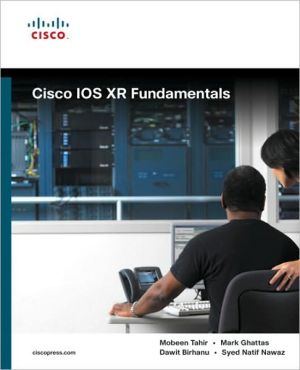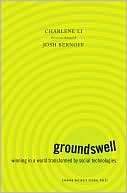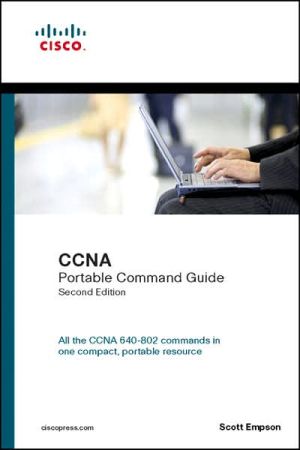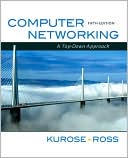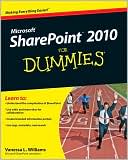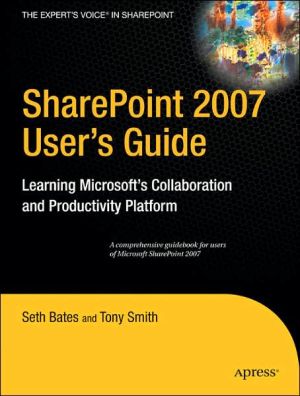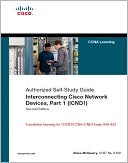Cisco IOS XR Fundamentals (Networking Technology Series)
Cisco IOS XR Fundamentals is a systematic, authoritative guide to configuring routers with Cisco IOS® XR, the next-generation flagship Cisco® Internet operating system.\ In this book, a team of Cisco experts brings together quick, authoritative, and example-rich reference information for all the commands most frequently used to configure and troubleshoot Cisco IOS XR-based routers in both service provider and enterprise environments.\ The authors walk you through the details of the Cisco IOS...
Search in google:
Cisco IOS XR Fundamentals is a systematic, authoritative guide to configuring routers with Cisco IOS® XR, the next-generation flagship Cisco® Internet operating system.In this book, a team of Cisco experts brings together quick, authoritative, and example-rich reference information for all the commands most frequently used to configure and troubleshoot Cisco IOS XR-based routers in both service provider and enterprise environments.The authors walk you through the details of the Cisco IOS XR architecture and explain commands in the new Cisco IOS XR CLI wherever required. They present concise explanations of service provider requirements and internetwork theory, backed by proven sample configurations for IOS XR services, MPLS, multicast, system management, system security, routing, and interfaces.Cisco IOS XR Fundamentals is an indispensable resource for designing, implementing, troubleshooting, administering, or selling networks containing Cisco IOS XR–supported routers. This is the only Cisco IOS XR book that: Clearly explains how Cisco IOS XR meets the emerging requirements of both current and future networks Gives network professionals extensive information for simplifying migration and taking full advantage of Cisco IOS XR’s new power Presents detailed, tested configuration examples that network professionals can apply in their own networks Walks through using new Cisco IOS XR features and the In-Service Software Upgrade (ISSU) process to minimize downtime and costMobeen Tahir, CCIE® No. 12643 (R&S, SP), is a Cisco network consulting engineer with more than a decade of experience in designing and deploying service provider networks. He currently works for the WWSP practice team, which provides consulting services to Cisco NGN customers.Mark Ghattas, CCIE No. 19706 (Service Provider), is a solution architect at Cisco and has been in the networking industry for more than 15 years. He focuses on IOS XR–based platforms for service providers and currently manages the World Wide Service Provider Practice team in Advanced Services.Dawit Birhanu, CCIE No. 5602, is a technical leader at Cisco. He assists global service providers in deploying new NGN products and technologies. He specializes in IOS XR–based platforms, QoS, MPLS, and BGP.Syed Natif Nawaz, CCIE No. 8825 (R&S, SP), has more than 10 years' experience in providing networking design, deployment, and escalation assistance to service provider customers. He is currently the IOS XE software development manager at Cisco, where he works on customer-focused software qualification, certification, and deployment; feature integration; release processes; and other software quality initiatives. Use Cisco IOS XR to deliver superior scalability, availability, security, and service flexibility Understand the Cisco IOS XR distributed, modular architecture Design, implement, and troubleshoot networks containing Cisco IOS XR–supported routers Configure Cisco IOS XR routing, including RIP, IS-IS, OSPF, and EIGRP Learn BGP implementation details specific to Cisco IOS XR and using RPL to influence policies Manage IP addresses and Cisco IOS XR services Secure Cisco IOS XR using standard and extended ACLs, prefix lists, and uRPF Master all facets of MPLS configuration, including LDP, L3VPN, and TE Configure PIM, IGMP, and static RP multicast Optimize networks using advanced Cisco IOS XR features, including secure domain routers Learn building blocks of Multishelf, and understand configurations and migration techniquesThis book is part of the Cisco Press® Fundamentals Series. Books in this series introduce networking professionals to new networking technologies, covering network topologies, sample deployment concepts, protocols, and management techniques.Category: Networking: Routing and SwitchingCovers: Cisco IOS XR
Cisco IOS XR FundamentalsCisco IOS XR FundamentalsIntroduction\ This book is intended to provide a reference to users who plan or have implemented Cisco IOS XR software in the network. Cisco IOS XR Fundamentals provides an overview of IOS XR operation system infrastructure and hardware architecture on the Carrier Routing System. The intention of this book is to provide general networking topics in IOS XR that service providers may implement in the core network. It is not feasible to cover every aspect of IOS XR; however, the key configurations have been explained that are typically deployed in core networks.\ Who Should Read This Book?\ Readers who have a relatively strong working knowledge of Cisco IOS Software and routing protocols will benefit from the discussions and configuration examples presented.\ How This Book Is Organized\ Although this book could be read cover to cover, it is designed to provide a configuration overview on Cisco IOS XR to support implementation configuration and features in IOS XR. Chapter 1 provides an overview of the evolution of operating systems and an understanding of the underlying QNX operating system. Chapters 2 through 12 are the core chapters and can be covered in order. If you do intend to read them all, the order in the book is an excellent sequence to use.\ Chapters 1 through 12 cover the following topics:\ \ Chapter 1, “Introducing Cisco IOS XR”: This chapter discusses the evolution of network operating systems in service provider enviroments. It is important to understand the goals and requirement of service providers that influenced the goals of IOS XR.\ Chapter 2, “Cisco IOS XR Infrastructure”: This chapter discusses the interworkings of IOS XR. It helps you understand IOS XR microkernel architecture, process scheduling, interprocess communications, system database, and distributed services.\ Chapter 3, “Installing Cisco IOS XR”: This chapter discusses various procedures for installing IOS XR on the Carrier Routing System.\ Chapter 4, “Configuration Management”: This chapter provides a deeper insight into how IOS XR is different when configuring interfaces, out of band management, and features such as rollback and commit commands. Understanding these features will help you better manage the system.\ Chapter 5, “Cisco IOS XR Monitoring and Operations”: This chapter explores how monitoring works in IOS XR. As IOS XR operates as a real-time operating system, there are monitoring tools that provide deeper inspection of activities on the system.\ Chapter 6, “Cisco IOS XR Security”: This chapter examines inherent policers that provide a layer of security within the operating system. The importance of Local Packet Transport System (LPTS) is discussed.\ Chapter 7, “Routing IGP”: This chapter covers the basics of routing protocol configurations. It provides configuration examples to show how IGP features are configured in IOS XR.\ Chapter 8, “Implementing BGP in Cisco IOS XR”: This chapter introduces the IOS XR implementation of BGP. This chapter assumes that you have prior experince and knowledge of the BGP protocol and focuses on unique aspects of IOS XR BGP configuration. This chapter also provides details on Routing Policy Language as a vehicle for implementing BGP routing policies.\ Chapter 9, “Cisco IOS XR MPLS Architecture”: This chapter discusses Multiprotocol Label Switching (MPLS), an important technology for building converged network infrastructure and services. This chapter assumes that you are familiar with MPLS protocols and operations. This chapter discusses IOS XR MPLS architecture, features, implementation, and configuration. It covers LDP, Layer 3 VPN, VPWS, VPLS, and MPLS Traffic Engineering.\ Chapter 10, “Cisco IOS XR Multicast”: This chapter discusses when to use queuing and which queuing technique to use. This chapter also examines Weighted Fair Queuing (WFQ), Custom Queuing, and Priority Queuing and addresses the need for compression in today’s enterprise network.\ Chapter 11, “Secure Domain Router”: This chapter covers the concept of SDRs. It discusses the Distributed Route Processor (DRP) hardware needed to implement SDRs and provides configuration examples.\ Chapter 12, “Understanding CRS-1 Multishelf”: This chapter discusses the Cisco implementation of the CRS-1 multishelf system. The key components are discussed to understand the architecture and troubleshooting of a CRS-1 multishelf system. A fabric troubleshooting section is covered to support implementation and operation.\ \ © Copyright Pearson Education. All rights reserved.
ForewordIntroductionChapter 1 Introducing Cisco IOS XREvolution of NetworkingRequirements for Carrier-Grade NOSConvergenceScalabilityAvailabilityHardware RedundancyFailure Recovery and Microkernel-Based NOSProcess RestartabilityFailure DetectionSoftware Upgrades and PatchingSecurityService FlexibilityOperating System ConceptsBasic Functions of an Operating SystemProcess SchedulingInterrupt HandlingMemory ManagementSynchronizationInterprocess CommunicationDynamic Link LibraryPortable Operating System InterfaceHigh-Level Overview of Cisco IOS XRCisco IOS XR PlatformsCisco CRS-1 Carrier Routing SystemCisco XR 12000 SeriesCisco ASR 9000 SeriesChapter 2 Cisco IOS XR InfrastructureCisco IOS XR KernelThreadsScheduling AlgorithmsSynchronization ServicesCisco IOS XR System ManagerProcess AttributesSystem Manager and Process LifecycleCLI for Sysmgr and ProcessesInterprocess CommunicationCharacteristics of IPC MechanismsSynchronous Versus AsynchronousIntra-node Versus Inter-nodeConnection-Oriented Versus RendezvousPoint-to-Point Versus Point-to-MultipointLight Weight MessagingGroup Service ProtocolAtomic Descriptor RingQnetDistributed ServicesGSPBulk Content DownloaderProcess PlacementCisco IOS XR System DatabaseHigh Availability ArchitectureForwarding PathChapter 3 Installing Cisco IOS XRIntroduction to Cisco IOS XR PackagesImage Naming ConventionsCisco IOS XR Bootable Files, PIEs, and SMUsComposite Bootable FilesComposite Upgrade PIEOptional PIEsSoftware Maintenance UpgradeInstall System OverviewPreparing to Install Cisco IOS XRTURBOBOOTSetting the TURBOBOOT ROMMON VariableBooting the .vm File from ROMMONVerifying the Software InstallationInstalling PackagesTURBOBOOT Considerations for the c12000 PlatformBooting the Standby RPUpgrading to a Major Cisco IOS XR Version Using mini.pieInstall RollbackRemoving Inactive PackagesPerforming an Install AuditDisk Backup and RecoveryCreating a Backup Disk with Golden DiskDisk MirroringCreating a Disk PartitionTurning On Disk MirroringInstall Health ChecksVerifying MD5 Signature of a PIE or an SMUAnticipating Disk Space UsageTesting a PIE or SMU InstallationVerifying the config-registerClearing Configuration InconsistencyChapter 4 Configuration ManagementUnderstanding Distributed Configuration ManagementControl Plane Configuration ManagementData Plane Configuration ManagementUnderstanding Configuration PlanesAdmin PlaneShared PlaneLocal PlaneComponents of Configuration ManagementConfiguration ManagerConfiguration File SystemRole of SysDB in Configuration ManagementReplicated Data Service File SystemUnderstanding the Two-Stage Commit ModelBuilding the Target ConfigurationCommit OperationCommit Confirmed OptionCommit FailuresConfiguration Failures During StartupConfiguration Features in Cisco IOS XRDeleting Physical InterfaceConfiguration NavigationDefault Running Configuration BehaviorTroubleshooting Configuration InconsistenciesConfiguration Session LockAvoiding a Commit Operation and Clearing the Target ConfigurationsOption 1: Unlock the Configuration SessionOption 2: Use the clear CommandOption 3: Use the abort CommandOption 4: Use the end or exit CommandsConfiguration Management During Hardware and Software Change EventsConfiguration Management During Online Insertion and Removal EventsCase 1: Insert or Remove a NodeCase 2: Replace the Node with a Different NodeCase 3: Replace the Node with a Higher Density NodeCase 4: Replace the Node with a Lower Density NodeConfiguration Management During Package Activation and DeactivationInterface PreconfigurationConfiguration TemplateConfiguration Management During Router StartupConfiguration RollbackChapter 5 Cisco IOS XR Monitoring and OperationsUsing SNMPConfiguring SNMPCisco IOS XR SyslogSNMP in the Context of a VRFLogging DestinationLocal Archiving of Logging MessagesEmbedded Event ManagerEEM Event Detectors and Events ProcessingTimer Services Event DetectorSyslog Event DetectorNone Event DetectorWatchdog System Monitor Event DetectorDistributed Event DetectorsRegistering and Using Onboard EEM PoliciesUser-Defined EEM PolicyEEM Reliability MetricsMonitoring ProcessesWDSYSMONMonitoring MemoryUsing the show system verify CommandOperations and Monitoring Best PracticesChapter 6 Cisco IOS XR SecuritySecure Operating SystemSecuring Access to the RouterAdmin PlaneSDR PlaneUser Groups and Task GroupsUser Group and Task Group InheritanceExternal AAAConfiguring a TACACS+ ServerAuthentication Using RADIUSConfiguring Secure ShellManagement Plane ProtectionSecuring the Forwarding PlaneAccess Control ListsUnicast RPFLocal Packet Transport ServiceMechanics Behind LPTS: A High-Level OverviewConfiguring LPTSChapter 7 Routing IGPRouting Information ProtocolUnderstanding RIP FundamentalsRIP VersionsConfiguring RIP in Cisco IOS XRConfiguring Route Policy LanguageConfiguring Passive InterfaceRestarting, Shutting Down, and Blocking RIPVerifying and Troubleshooting RIPEnhanced Interior Gateway Routing ProtocolUnderstanding EIGRP FundamentalsNeighbor Discovery/RecoveryReliable Transport ProtocolDiffusing Update AlgorithmProtocol-Dependent ModulesConfiguring EIGRP in Cisco IOS XRConfiguring Routing PolicyConfiguring Router IDConfiguring and Verifying NSFVerifying EIGRP Process StatusVerifying and Troubleshooting EIGRPOpen Shortest Path FirstUnderstanding OSPF FundamentalsConfiguring OSPF in Cisco IOS XRConfiguring and Verifying OSPFv2Hierarchical CLI and InheritanceConfiguring OSPFv2 AuthenticationVerifying NSF Configuration and Standby RP StatusConfiguring and Verifying Nonstop RoutingConfiguring and Verifying Multiarea AdjacenciesConfiguring and Verifying Bidirectional Forwarding DetectionConfiguring OSPF TimersConfiguring and Verifying OSPFv3Intermediate System to Intermediate SystemUnderstanding IS-IS FundamentalsConfiguring IS-IS in Cisco IOS XRVerifying the Single Topology ModelConfiguring and Verifying the Multitopology ModelConfiguring and Verifying Interface StatesConfiguring IS-IS NSF and IS-IS TimersConfiguring and Verifying BFD in IS-ISConfiguring and Verifying IP Fast RerouteConfiguring and Verifying Authentication in IOS XR IS-ISChapter 8 Implementing BGP in Cisco IOS XRCisco IOS XR BGP Architectural OverviewCisco IOS XR BGP Hierarchical ConfigurationAddress Family Configuration ModeConfiguration GroupsImplementing BGP PoliciesRouting Policy LanguagePrefix SetAS-path SetCommunity SetRouting PoliciesHierarchical Policies and ParameterizationBGP Policy AccountingBGP Remotely Triggered Black HoleBGP Graceful RestartBGP Distributed SpeakerCisco IOS XR BGP ConvergenceChapter 9 Cisco IOS XR MPLS ArchitectureUnderstanding Cisco IOS XR MPLS Architecture FundamentalsTTL ProcessingCisco IOS XR MPLS Load BalancingLabel Distribution ProtocolLDP Basic ConfigurationLDP ParametersLDP Label ControlLDP-IGP Sync and LDP Session ProtectionMPLS Traffic EngineeringCisco IOS XR Peer-to-Peer L3VPNVirtual Routing Forwarding TablesMP-iBGP Between PE RoutersRouting Between CE and PEStatic Routing for CE-PEeBGP as CE-PE ProtocolOSPF as CE-PE ProtocolRIP as CE-PE ProtocolL2VPNVirtual Private Wire ServiceVPWS Configuration in IOS XRPseudo Wire RedundancyVirtual Private VLAN ServiceChapter 10 Cisco IOS XR MulticastUnderstanding Multicast Routing FundamentalsInternet Group Management ProtocolIGMPv2IGMPv3Protocol Independent MulticastUnderstanding Cisco IOS XR MulticastUnderstanding Cisco IOS XR PIM Sparse ModeUnderstanding PIM Source Specific Multicast on IOS XRConfiguring Cisco IOS XR MulticastEnabling Multicast RoutingConfiguring IGMPConfiguring PIMConfiguring Static RPAuto-RPBSRPIM SSM ConfigurationMonitoring and Troubleshooting Cisco IOS XR MulticastDebugging Multicast on the CRS Router’s Ingress PathDebugging Multicast in Router’s Fabric and Egress PathDebugging an RPF Failure Using a Line Card MFIB CommandChapter 11 Secure Domain RouterOwner and Non-Owner SDRUnderstanding SDR PrivilegesCreating a Secure Domain RouterDRPConfiguring a Secure Domain RouterCreating a Named Secure Domain RouterAssigning Resources to a Named SDRLogging In to a Newly Named SDRProcess PlacementChapter 12 Understanding CRS-1 MultishelfMultishelf OverviewLine Card ChassisFabric Card ChassisSwitch Fabric CardsFabric Data PathHigh AvailabilityMultishelf Fabric InterconnectFabric PlanesSEA LinksFabric BackpressureOptical Array CablesRecommended Practices and ConsiderationsSingle Module Fabric ConfigurationMultimodule ConfigurationMultishelf Control EthernetMultishelf ConfigurationViewing the ConfigurationLine Card Chassis to Multishelf PreparationTroubleshooting Multishelf Fabric PlanesTroubleshooting Fabric LinksAppendix A ROMMON and Configuration Register SettingsAppendix B Multishelf 2+1 Array Cable MappingAppendix C Switch Fabric Down Flags9781587052712 TOC 5/19/2009
